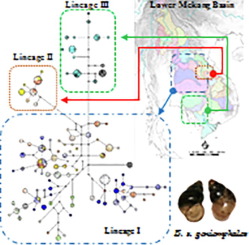当前位置:
X-MOL 学术
›
Int. J. Parasitol.
›
论文详情
Our official English website, www.x-mol.net, welcomes your feedback! (Note: you will need to create a separate account there.)
Genetic structure and geographical variation of Bithynia siamensis goniomphalos sensu lato (Gastropoda: Bithyniidae), the snail intermediate host of Opisthorchis viverrini sensu lato (Digenea: Opisthorchiidae) in the Lower Mekong Basin revealed by mitochondrial DNA sequences.
International Journal for Parasitology ( IF 4 ) Pub Date : 2019-12-18 , DOI: 10.1016/j.ijpara.2019.10.007 Chairat Tantrawatpan 1 , Weerachai Saijuntha 2 , Naruemon Bunchom 2 , Warong Suksavate 3 , Warayutt Pilap 2 , Tanapipat Walalite 2 , Takeshi Agatsuma 4 , Wittaya Tawong 5 , Paiboon Sithithaworn 6 , Ross H Andrews 7 , Trevor N Petney 8
International Journal for Parasitology ( IF 4 ) Pub Date : 2019-12-18 , DOI: 10.1016/j.ijpara.2019.10.007 Chairat Tantrawatpan 1 , Weerachai Saijuntha 2 , Naruemon Bunchom 2 , Warong Suksavate 3 , Warayutt Pilap 2 , Tanapipat Walalite 2 , Takeshi Agatsuma 4 , Wittaya Tawong 5 , Paiboon Sithithaworn 6 , Ross H Andrews 7 , Trevor N Petney 8
Affiliation

|
The freshwater snail Bithynia siamensis goniomphalos sensu lato is widely distributed in the Lower Mekong Basin where it acts as the first intermediate host of the liver fluke Opisthorchis viverrini, a group 1 carcinogen causing cholangiocarcinoma. This study explores the genetic structure and geographical variation of B. s. goniomphalos from eight previously studied catchments and eight new catchments. These catchments belong to five previously studied catchment systems and one new catchment system (Tonlesap) in the Lower Mekong Basin. Two new catchment systems, Prachin Buri and Bang Pakong from eastern and central Thailand, respectively, were also examined. We collected 289 specimens of B. s. goniomphalos from 15 previously studied localities and 18 new localities in Thailand, Lao PDR (People's Democratic Republic), and Cambodia. The mitochondrial cytochrome c oxidase subunit 1 and 16S ribosomal DNA sequences were used to determine genetic variation. Classification of haplotypes specified 100 at the cox1 locus and 15 at the rrnL locus. Comparison between 16 catchment populations found significant genetic differences (ФST) between all populations. The phylogenetic tree and haplotype network analyses classified B. s. goniomphalos into three evolutionary lineages (lineage I-III). Lineage I contained B. s. goniomphalos from the Mekong, Chi, Mun, Prachin Buri and Bang Pakong catchments in Thailand, including the Nam Ngum catchment in Lao PDR. Lineage II contained all specimens from the Tonlesap catchment, whereas lineage III contained specimens from the Mekong and Sea Bang Heang catchments in Thailand and Lao PDR, respectively. Interestingly, Bithynia siamensis siamensis was placed between lineages I and II of B. s. goniomphalos. This study supports the hypothesis that B. s. goniomphalos is a species complex containing at least three distinct evolutionary lineages in the Lower Mekong Basin, and that comprehensive molecular genetic analyses need to be conducted to further our understanding of the evolutionary and systematic relationships of these Bithynia snail taxa.
中文翻译:

线粒体DNA序列揭示了湄公河下游流域的美人鱼(Opishorchis viverrini sensu lato)(蜗牛)的蜗牛中间寄主:Bithynia siamensis goniomphalos sensu lato(天麻:Bithyniidae)的遗传结构和地理变异。
淡水蜗牛Bithynia siamensis goniomphalos sensu lato广泛分布于湄公河下游地区,是淡水蜗牛Opisthorchis viverrini的第一个中间宿主,后者是引起胆管癌的第1类致癌物。本研究探索了伯氏芽孢杆菌的遗传结构和地理变异。来自八个先前研究过的集水区和八个新集水区的淋病菌。这些集水区属于湄公河下游盆地的五个先前研究的集水系统和一个新的集水系统(Tonlesap)。还研究了两种新的集水系统,分别来自泰国东部和中部的Prachin Buri和Bang Pakong。我们收集了289个B. s。的标本。来自泰国,老挝人民民主共和国和柬埔寨的15个先前研究过的地区和18个新的地区的淋病菌。线粒体细胞色素c氧化酶亚基1和16S核糖体DNA序列用于确定遗传变异。单倍型的分类在cox1位点指定为100,在rrnL位点指定为15。比较16个流域人口,发现所有人口之间存在显着的遗传差异(ФST)。系统发育树和单倍型网络分析分类的B. s。淋病菌分为三个进化谱系(谱系I-III)。世系我包含B. 来自泰国湄公河,Chi,Mun,Prachin Buri和Bang Pakong流域的淋菌,包括老挝人民民主共和国的Nam Ngum流域。谱系II包含了Tonlesap流域的所有标本,而谱系III分别包含了泰国和老挝人民民主共和国的湄公河和Sea Bang Heang流域的标本。有趣的是,中华Bithynia siamensis siamensis被置于B. s。的谱系I和II之间。淋病菌。这项研究支持了B. s。goniomphalos是一个物种复合体,在湄公河下游盆地至少包含三个不同的进化谱系,需要进行全面的分子遗传分析以进一步了解这些Bithynia蜗牛类群的进化和系统关系。
更新日期:2019-12-19
中文翻译:

线粒体DNA序列揭示了湄公河下游流域的美人鱼(Opishorchis viverrini sensu lato)(蜗牛)的蜗牛中间寄主:Bithynia siamensis goniomphalos sensu lato(天麻:Bithyniidae)的遗传结构和地理变异。
淡水蜗牛Bithynia siamensis goniomphalos sensu lato广泛分布于湄公河下游地区,是淡水蜗牛Opisthorchis viverrini的第一个中间宿主,后者是引起胆管癌的第1类致癌物。本研究探索了伯氏芽孢杆菌的遗传结构和地理变异。来自八个先前研究过的集水区和八个新集水区的淋病菌。这些集水区属于湄公河下游盆地的五个先前研究的集水系统和一个新的集水系统(Tonlesap)。还研究了两种新的集水系统,分别来自泰国东部和中部的Prachin Buri和Bang Pakong。我们收集了289个B. s。的标本。来自泰国,老挝人民民主共和国和柬埔寨的15个先前研究过的地区和18个新的地区的淋病菌。线粒体细胞色素c氧化酶亚基1和16S核糖体DNA序列用于确定遗传变异。单倍型的分类在cox1位点指定为100,在rrnL位点指定为15。比较16个流域人口,发现所有人口之间存在显着的遗传差异(ФST)。系统发育树和单倍型网络分析分类的B. s。淋病菌分为三个进化谱系(谱系I-III)。世系我包含B. 来自泰国湄公河,Chi,Mun,Prachin Buri和Bang Pakong流域的淋菌,包括老挝人民民主共和国的Nam Ngum流域。谱系II包含了Tonlesap流域的所有标本,而谱系III分别包含了泰国和老挝人民民主共和国的湄公河和Sea Bang Heang流域的标本。有趣的是,中华Bithynia siamensis siamensis被置于B. s。的谱系I和II之间。淋病菌。这项研究支持了B. s。goniomphalos是一个物种复合体,在湄公河下游盆地至少包含三个不同的进化谱系,需要进行全面的分子遗传分析以进一步了解这些Bithynia蜗牛类群的进化和系统关系。



























 京公网安备 11010802027423号
京公网安备 11010802027423号